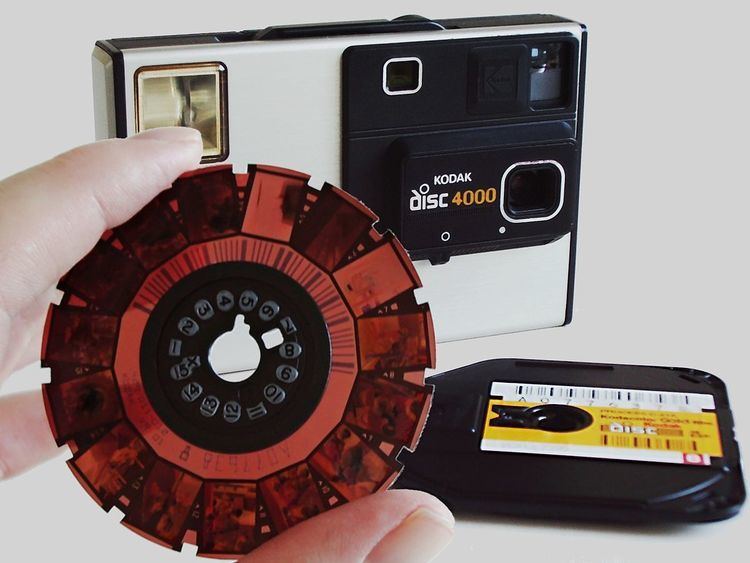 | ||
Similar Instant film, Film gauge, Sheet film | ||
Disc film was a still-photography film format aimed at the consumer market, and introduced by Kodak in 1982.
Contents
The film was in the form of a flat disc, and was fully housed within a plastic cartridge. Each disc held fifteen 10 × 8 mm exposures, arranged around the outside of the disc, with the disc being rotated 24° between each image.
The system was a consumer-oriented product, and most cameras were self-contained units with no expansion capability. The disc film allowed them to be compact and considerably thinner than other cameras. The cameras were very simple to load and unload, and were generally completely automated. The cassette had a built-in dark slide to prevent stray light reaching the film when the disc was removed.
As the film was rotated on a disc instead of over a spool, the cassette was very thin. The flat nature of the format also led to the (potential) advantage of greater sharpness over curved spool-based cassette formats (such as Minox film, 110 and 126 film). Disc film has a very thick acetate base, comparable thickness with 4×5" sheet film, which holds the film much flatter than the other formats of the time.
Disc film did not prove hugely successful, mainly because the image on the negative was only 10 mm by 8 mm, leading to generally unacceptable grain and poor definition in the final prints from the analog imaging equipment used at the time. The film was intended to be printed with special 6-element lenses from Kodak, but many labs simply printed discs with standard 3-element lenses used for larger negative formats. The resulting prints often disappointed the consumer. Few labs made the investment required to get the best out the small negative size. A problem with labs of the time was the manual nature of processing the color negative film. This was essentially a manual process, unlike spool-based films, whose chemical processing could be fully automated.
The film was officially discontinued by the last manufacturer, Kodak, on December 31, 1999, though the cameras had disappeared from the market long before then.
There were several different manufacturers of Disc film. Kodak produced films throughout the complete lifespan of the format, but 3M, Konica and Fuji also produced Disc film. While Kodak film was always eponymous, 3M and Konica made Disc film for many third parties, branded with the retailer's logo. As with most photographic film, for such white-label products the country of manufacture provides the best indication as to the actual manufacturer.
Kodak's newest ideas with sharp fine-grained negative film were always tested in Disc format first, typically being one or two generations ahead of the equivalent 135 films.
The 1983 "Minolta Disc-7" camera introduced a predecessor of the selfie stick - a convex mirror on its front to allow the composition of self-portraits, and its packaging showed the camera mounted on a stick while used for such a purpose.
Film history
Modern usage
There are still a small number of labs remaining in North America and the UK able to develop unprocessed disc film. Examples are as of June 2015:
Disc film is not available to purchase new due to the very complex design. No manufacturers remain, nor are any likely to recommence production.
